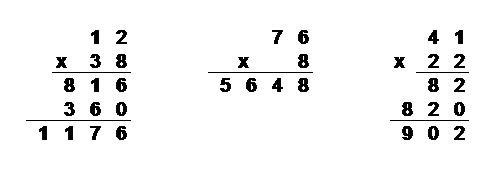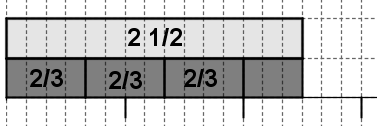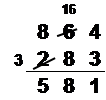Hints will display for most wrong answers; explanations for most right answers. You can attempt a question multiple times; it will only be scored correct if you get it right the first time.
I used the official objectives and sample test to construct these questions, but cannot promise that they accurately reflect what’s on the real test. Some of the sample questions were more convoluted than I could bear to write. See terms of use. See the MTEL Practice Test main page to view random questions on a variety of topics or to download paper practice tests.
MTEL General Curriculum Mathematics Practice
Question 1 |
The following story situations model \( 12\div 3\):
I) Jack has 12 cookies, which he wants to share equally between himself and two friends. How many cookies does each person get?
II) Trent has 12 cookies, which he wants to put into bags of 3 cookies each. How many bags can he make?
III) Cicely has $12. Cookies cost $3 each. How many cookies can she buy?
Which of these questions illustrate the same model of division, either partitive (partioning) or measurement (quotative)?
I and II | |
I and III | |
II and IIIHint: Problem I is partitive (or partitioning or sharing) -- we put 12 objects into 3 groups. Problems II and III are quotative (or measurement) -- we put 12 objects in groups of 3. | |
All three problems model the same meaning of division |
Question 2 |
Here is a student's work on several multiplication problems:
 For which of the following problems is this student most likely to get the correct solution, even though he is using an incorrect algorithm?
For which of the following problems is this student most likely to get the correct solution, even though he is using an incorrect algorithm?
58 x 22Hint: This problem involves regrouping, which the student does not do correctly. | |
16 x 24Hint: This problem involves regrouping, which the student does not do correctly. | |
31 x 23Hint: There is no regrouping with this problem. | |
141 x 32Hint: This problem involves regrouping, which the student does not do correctly. |
Question 3 |
Use the samples of a student's work below to answer the question that follows:
This student divides fractions by first finding a common denominator, then dividing the numerators.
\( \large \dfrac{2}{3} \div \dfrac{3}{4} \longrightarrow \dfrac{8}{12} \div \dfrac{9}{12} \longrightarrow 8 \div 9 = \dfrac {8}{9}\) \( \large \dfrac{2}{5} \div \dfrac{7}{20} \longrightarrow \dfrac{8}{20} \div \dfrac{7}{20} \longrightarrow 8 \div 7 = \dfrac {8}{7}\) \( \large \dfrac{7}{6} \div \dfrac{3}{4} \longrightarrow \dfrac{14}{12} \div \dfrac{9}{12} \longrightarrow 14 \div 9 = \dfrac {14}{9}\)Which of the following best describes the mathematical validity of the algorithm the student is using?
It is not valid. Common denominators are for adding and subtracting fractions, not for dividing them.Hint: Don't be so rigid! Usually there's more than one way to do something in math. | |
It got the right answer in these three cases, but it isn‘t valid for all rational numbers.Hint: Did you try some other examples? What makes you say it's not valid? | |
It is valid if the rational numbers in the division problem are in lowest terms and the divisor is not zero.Hint: Lowest terms doesn't affect this problem at all. | |
It is valid for all rational numbers, as long as the divisor is not zero.Hint: When we have common denominators, the problem is in the form a/b divided by c/b, and the answer is a/c, as the student's algorithm predicts. |
Question 4 |
Use the samples of a student's work below to answer the question that follows:
\( \large \dfrac{2}{3}\times \dfrac{3}{4}=\dfrac{4\times 2}{3\times 3}=\dfrac{8}{9}\) \( \large \dfrac{2}{5}\times \dfrac{7}{7}=\dfrac{7\times 2}{5\times 7}=\dfrac{2}{5}\) \( \large \dfrac{7}{6}\times \dfrac{3}{4}=\dfrac{4\times 7}{6\times 3}=\dfrac{28}{18}=\dfrac{14}{9}\)Which of the following best describes the mathematical validity of the algorithm the student is using?
It is not valid. It never produces the correct answer.Hint: In the middle example,the answer is correct. | |
It is not valid. It produces the correct answer in a few special cases, but it‘s still not a valid algorithm.Hint: Note that this algorithm gives a/b divided by c/d, not a/b x c/d, but some students confuse multiplication and cross-multiplication. If a=0 or if c/d =1, division and multiplication give the same answer. | |
It is valid if the rational numbers in the multiplication problem are in lowest terms.Hint: Lowest terms is irrelevant. | |
It is valid for all rational numbers.Hint: Can't be correct as the first and last examples have the wrong answers. |
Question 5 |
Which of the following values of x satisfies the inequality \( \large \left| {{(x+2)}^{3}} \right|<3?\)
\( \large x=-3\) Hint: \( \left| {{(-3+2)}^{3}} \right|\)=\( \left | {(-1)}^3 \right | \)=\( \left | -1 \right |=1 \) . | |
\( \large x=0\) Hint: \( \left| {{(0+2)}^{3}} \right|\)=\( \left | {2}^3 \right | \)=\( \left | 8 \right | \) =\( 8\) | |
\( \large x=-4\) Hint: \( \left| {{(-4+2)}^{3}} \right|\)=\( \left | {(-2)}^3 \right | \)=\( \left | -8 \right | \) =\( 8\) | |
\( \large x=1\) Hint: \( \left| {{(1+2)}^{3}} \right|\)=\( \left | {3}^3 \right | \)=\( \left | 27 \right | \) = \(27\) |
Question 6 |
Below is a pictorial representation of \(2\dfrac{1}{2}\div \dfrac{2}{3}\):

Which of the following is the best description of how to find the quotient from the picture?
The quotient is \(3\dfrac{3}{4}\). There are 3 whole blocks each representing \(\dfrac{2}{3}\) and a partial block composed of 3 small rectangles. The 3 small rectangles represent \(\dfrac{3}{4}\) of \(\dfrac{2}{3}\). | |
The quotient is \(3\dfrac{1}{2}\). There are 3 whole blocks each representing \(\dfrac{2}{3}\) and a partial block composed of 3 small rectangles. The 3 small rectangles represent \(\dfrac{3}{6}\) of a whole, or \(\dfrac{1}{2}\).Hint: We are counting how many 2/3's are in 2 1/2: the unit becomes 2/3, not 1. | |
The quotient is \(\dfrac{4}{15}\). There are four whole blocks separated into a total of 15 small rectangles.Hint: This explanation doesn't make much sense. Probably you are doing "invert and multiply," but inverting the wrong thing. | |
This picture cannot be used to find the quotient because it does not show how to separate \(2\dfrac{1}{2}\) into equal sized groups.Hint: Study the measurement/quotative model of division. It's often very useful with fractions. |
Question 7 |
Which of the following inequalities describes all values of x with \(\large \dfrac{x}{2}\le \dfrac{x}{3}\)?
\( \large x < 0\) Hint: If x =0, then x/2 = x/3, so this answer can't be correct. | |
\( \large x \le 0\) | |
\( \large x > 0\) Hint: If x =0, then x/2 = x/3, so this answer can't be correct. | |
\( \large x \ge 0\) Hint: Try plugging in x = 6. |
Question 8 |
The expression \( \large {{7}^{-4}}\cdot {{8}^{-6}}\) is equal to which of the following?
\( \large \dfrac{8}{{{\left( 56 \right)}^{4}}}\) Hint: The bases are whole numbers, and the exponents are negative. How can the numerator be 8? | |
\( \large \dfrac{64}{{{\left( 56 \right)}^{4}}}\) Hint: The bases are whole numbers, and the exponents are negative. How can the numerator be 64? | |
\( \large \dfrac{1}{8\cdot {{\left( 56 \right)}^{4}}}\) Hint: \(8^{-6}=8^{-4} \times 8^{-2}\) | |
\( \large \dfrac{1}{64\cdot {{\left( 56 \right)}^{4}}}\) |
Question 9 |
The expression \( \large{{8}^{3}}\cdot {{2}^{-10}}\) is equal to which of the following?
\( \large 2\) Hint: Write \(8^3\) as a power of 2. | |
\( \large \dfrac{1}{2}\) Hint: \(8^3 \cdot {2}^{-10}={(2^3)}^3 \cdot {2}^{-10}\) =\(2^9 \cdot {2}^{-10} =2^{-1}\) | |
\( \large 16\) Hint: Write \(8^3\) as a power of 2. | |
\( \large \dfrac{1}{16}\) Hint: Write \(8^3\) as a power of 2. |
Question 10 |
The student used a method that worked for this problem and can be generalized to any subtraction problem.Hint: Note that this algorithm is taught as the "standard" algorithm in much of Europe (it's where the term "borrowing" came from -- you borrow on top and "pay back" on the bottom). | |
The student used a method that worked for this problem and that will work for any subtraction problem that only requires one regrouping; it will not work if more regrouping is required.Hint: Try some more examples. | |
The student used a method that worked for this problem and will work for all three-digit subtraction problems, but will not work for larger problems.Hint: Try some more examples. | |
The student used a method that does not work. The student made two mistakes that cancelled each other out and was lucky to get the right answer for this problem.Hint: Remember, there are many ways to do subtraction; there is no one "right" algorithm. |
Question 11 |
Which of the following is equivalent to \( \dfrac{3}{4}-\dfrac{1}{8}+\dfrac{2}{8}\times \dfrac{1}{2}?\)
\( \large \dfrac{7}{16}\) Hint: Multiplication comes before addition and subtraction in the order of operations. | |
\( \large \dfrac{1}{2}\) Hint: Addition and subtraction are of equal priority in the order of operations -- do them left to right. | |
\( \large \dfrac{3}{4}\) Hint: \( \dfrac{3}{4}-\dfrac{1}{8}+\dfrac{2}{8}\times \dfrac{1}{2}\)=\( \dfrac{3}{4}-\dfrac{1}{8}+\dfrac{1}{8}\)=\( \dfrac{3}{4}+-\dfrac{1}{8}+\dfrac{1}{8}\)=\( \dfrac{3}{4}\) | |
\( \large \dfrac{3}{16}\) Hint: Multiplication comes before addition and subtraction in the order of operations. |
Question 12 |
On a map the distance from Boston to Detroit is 6 cm, and these two cities are 702 miles away from each other. Assuming the scale of the map is the same throughout, which answer below is closest to the distance between Boston and San Francisco on the map, given that they are 2,708 miles away from each other?
21 cmHint: How many miles would correspond to 24 cm on the map? Try adjusting from there. | |
22 cmHint: How many miles would correspond to 24 cm on the map? Try adjusting from there. | |
23 cmHint: One way to solve this without a calculator is to note that 4 groups of 6 cm is 2808 miles, which is 100 miles too much. Then 100 miles would be about 1/7 th of 6 cm, or about 1 cm less than 24 cm. | |
24 cmHint: 4 groups of 6 cm is over 2800 miles on the map, which is too much. |
Question 13 |
A solution requires 4 ml of saline for every 7 ml of medicine. How much saline would be required for 50 ml of medicine?
\( \large 28 \dfrac{4}{7}\) ml Hint: 49 ml of medicine requires 28 ml of saline. The extra ml of saline requires 4 ml saline/ 7 ml medicine = 4/7 ml saline per 1 ml medicine. | |
\( \large 28 \dfrac{1}{4}\) ml Hint: 49 ml of medicine requires 28 ml of saline. How much saline does the extra ml require? | |
\( \large 28 \dfrac{1}{7}\) ml Hint: 49 ml of medicine requires 28 ml of saline. How much saline does the extra ml require? | |
\( \large 87.5\) ml Hint: 49 ml of medicine requires 28 ml of saline. How much saline does the extra ml require? |
Question 14 |
AHint: \(\frac{34}{135} \approx \frac{1}{4}\) and \( \frac{53}{86} \approx \frac {2}{3}\). \(\frac {1}{4}\) of \(\frac {2}{3}\) is small and closest to A. | |
BHint: Estimate with simpler fractions. | |
CHint: Estimate with simpler fractions. | |
DHint: Estimate with simpler fractions. |
Question 15 |
Here is a mental math strategy for computing 26 x 16:
Step 1: 100 x 16 = 1600
Step 2: 25 x 16 = 1600 ÷· 4 = 400
Step 3: 26 x 16 = 400 + 16 = 416
Which property best justifies Step 3 in this strategy?
Commutative Property.Hint: For addition, the commutative property is \(a+b=b+a\) and for multiplication it's \( a \times b = b \times a\). | |
Associative Property.Hint: For addition, the associative property is \((a+b)+c=a+(b+c)\) and for multiplication it's \((a \times b) \times c=a \times (b \times c)\) | |
Identity Property.Hint: 0 is the additive identity, because \( a+0=a\) and 1 is the multiplicative identity because \(a \times 1=a\). The phrase "identity property" is not standard. | |
Distributive Property.Hint: \( (25+1) \times 16 = 25 \times 16 + 1 \times 16 \). This is an example of the distributive property of multiplication over addition. |
If you found a mistake or have comments on a particular question, please contact me (please copy and paste at least part of the question into the form, as the numbers change depending on how quizzes are displayed). General comments can be left here.

